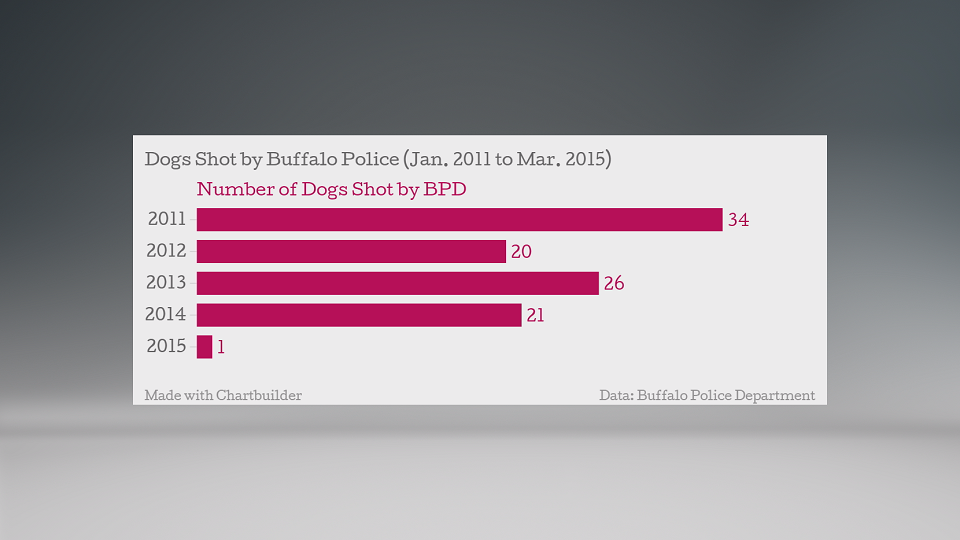BUFFALO, N.Y. – Buffalo Police officers have fired their weapons at 102 dogs since 2011, but incidents have dropped sharply since the implementation of new training methods in late 2014, according to departmental records.
WGRZ-TV's first investigation into officer-involved canine shootings aired in November 2014. An initial request of records under the state's Freedom of Information Law revealed that Buffalo Police shot at 92 dogs from Jan. 1, 2011 through September 2014, killing 73 dogs. One individual officer shot 26 of the dogs, killing 25 of them.
A few weeks after the story aired, Buffalo Police then added a new training program for canine encounters, derived from the U.S. Department of Justice's Community Oriented Policing Services Office. The Buffalo Police Department has refused all requests for a second interview this spring, but spokesman Michael DeGeorge said Monday morning that the department is currently in the process of training all officers on this new method.
The training program, which includes a series of five videos, teaches law enforcement officers how to read a dog's body language in order to improve interactions in the line of duty, among other tactics. The videos also offer guidance on "use of force considerations" and "legal considerations."
The program appears to have made an immediate impact in Buffalo.
In a follow-up request this spring, WGRZ-TV submitted a request under the Freedom of Information Law, looking for all weapon discharges from October 2014 through March 2015. The latest records indicate a significant decrease in dog shootings during the winter months.
Since the story aired in mid-November, Buffalo Police have shot two dogs. On Dec. 30, an officer shot three rounds at a pit bull during a narcotics search "to protect himself and entry team," according to the documents. In the second incident on Jan. 29, an officer fired four shots at a "large, aggressive Rottweiler." In both cases, the dogs died from their injuries.
The latest records from the police also bring the following incidents to light:
--Buffalo Police shot two dogs in October 2014, two dogs on November 4 and one dog on November 6.
--Buffalo Police shot a dog on three separate occasions in May 2012, May 2013 and May 2014, which were not previously included in the first round of records. The records officer for the Buffalo Police Department said in an email that he had no explanation for why the computer-automated system did not include those incidents in the initial request.
--Since 2011, almost all incidents of weapons discharges have involved dogs. On rare occasions during the past four years, police officers have also fired shots at armed or fleeing suspects, during traffic stops or under unclear circumstances. The department provided records for about a dozen of these incidents since 2011. It also provided records of about a dozen shots-fired incidents in which officers safely dispatched of deer under standard protocol.
--Of the 102 dogs shot by Buffalo Police between Jan. 1, 2011 and March 2015, roughly 80 percent of the incidents have resulted in fatalities.
--In 2013 alone, Buffalo Police Officers fired at 26 dogs. In 2013, police officers with the New York City Police Department, the largest force in the United States, fired at 23 dogs, according to the latest NYPD annual discharge report.
In the state of New York, no law currently exists to mandate canine encounter training for law enforcement. However, Colorado and Illinois already have laws to require training, and this spring, both chambers of the state legislature in Texas passed a bill requiring a "statewide comprehensive education and training program on animal encounters and animal behavior." That training will include "at least four hours" of classroom instruction about how to tame dogs in a non-lethal manner. The bill awaits the Governor's signature.
The momentum hasn't yet caught on in New York.
State Senator Patrick Gallivan (R-Elma), who served as Erie County Sheriff from 1998 to 2005, said he hasn't heard of required canine training in Albany.
"It's something that's never been brought to my attention," Gallivan said.
As Erie County Sheriff, Gallivan said he recalled incidents in which his deputies faced aggressive animals, but his office did not have an explicit policy to deal with those situations.
He learned of the Buffalo Police Department's dog shooting numbers after watching the WGRZ-TV report.
"I initially was surprised to hear that this happened with such frequency," Gallivan said. "Initially-- because it's not something you normally hear about."
Still, Gallivan cautioned against making snap judgments of the Buffalo Police Department's conduct.
"You've got to examine the situations," Gallivan said. "Just because we have a number out there that's higher than some… does not mean that there's a problem."
Gallivan said he's not ready to push for a state law, opting instead to allow departments the freedom of selecting their own training methods. Even in the absence of an explicit state law, the New York City Police Department has trained its officers for many years for dog encounters. The NYPD policy also provides written directives for officers to "attempt to prevent an animal attack using non-lethal options, including batons and OC spray."
Per capita, the NYPD annual discharge reports show that its officers have shot dogs at a far lower rate than Buffalo Police in recent years.
Police in Ithaca, N.Y., have also trained for dog encounters with a former police officer named Jim Osorio, a renowned nationwide trainer who is working extensively in Texas right now.
"It's something we'll now keep an eye out for," Gallivan said. "And if it appears to be a problem that needs a legislative solution, then that is something that I think we have an obligation to look at and do something about. But not everything requires a legislative solution."


